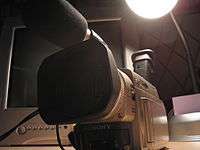Sony DCR-TRV900
The Sony DCR-TRV900 was a DV tape camcorder released by Sony in 1998, with an MSRP of USD $2699. It was intended as a high-end consumer camera, more portable and less expensive than the top-of-the-line DCR-VX1000. It became one of several Sony and Canon models popular in late-'90s desktop video production, delivering quality comparable to then-dominant analog Betacam hardware at a fraction of the cost. In 2002, Sony replaced the TRV900 with the somewhat less well-received DCR-TRV950.

The camcorder had three 1/4-inch CCDs, which provided an exceptionally high-quality video image for a handheld camcorder of the period. It also had a 3.5-inch LCD screen, a color viewfinder, a 12x optical zoom, a 48x digital zoom, and a manual focus ring. (Often overlooked in consumer camcorders, this feature allows you to focus using a mechanical ring around the lens, offering precise control.) The camcorder included a FireWire port for transferring video to a computer.
At the time, Sony had a pattern of releasing "professional" upgraded versions of their most popular consumer cameras, with the same chassis shape but made from more durable materials and in a darker color. Extra features included XLR inputs and the ability to record in the higher-grade DVCAM format. The TRV900's pro equivalent was the DSR-PD100, released in 2000; the TRV950's was the DSR-PDX10.
Specs
| Recording Format | Recording System | CCD Size | Optical Zoom | Digital Zoom | LCD Panel | Lens Focal Length |
|---|---|---|---|---|---|---|
| MiniDV | NTSC | 1/4″ | 12x | 48x | 3.5' with color viewfinder | 4.3 - 51.6 mm |
| Filter Diameter | Image Stabilizer | Low Light Rating | Recommended Illumination | Audio Format |
|---|---|---|---|---|
| 52 mm | With Image Stabilizer | 4 Lux | 100 Lux | 12/16 Bit PCM Digital Stereo/Audio Dub |
| Max Shutter Speed | Dimensions | Pros | Cons |
|---|---|---|---|
| 1/10,000 of a second | 3.75' x 4.13' x 7.63' | 3 CCDS, Full Manual Controls, Adjustable mic levels | No XLR inputs, some controls behind LCD |
TRV900 vs. TRV950

There are several differences between the two.
Chip Size
The TRV900 has 1/4' chips and the TRV950 has 1/4.7 which could mean the TRV900 produces better colors.
CCD Pixels
The TRV950 has substantially smaller CCD Pixels than the 900 with 380k pixels while the 950 has 690k.
LCD Monitor
Both have a 3.5" LCD Monitor.
Zoom
The only difference in zoom between the two is that the 900's digital zoom is 48x while the digital zoom for the TRV950 is 150x. Also the TRV950s zoom rocker is more sensitive.
Low Light
The TRV900 Low Light Rating is 4 lux while the TRV950 is 7 lux.
Progressive Mode
Although progressive mode on the TRV900 has a slow frame rate, the 950 has no explicit progressive mode. Running the "flash" digital effect at the lowest possible setting will simulate a progressive mode.
Audio
The TRV950 has a little more "hiss" than the TRV900. Also, the internal speaker of the TRV950 is smaller than the TRV900 and has less output.
A/D conversion and pass-through
The TRV950 has a fully functional analog to digital conversion and pass-through unlike the TRV900. The TRV900 will allow you to record from an analog source but will not directly convert the analog signal into DV when connected to a firewire port.
References
- Using the Sony DCR-TRV900 Camcorder (Full Review)
- TRV900 FAQ